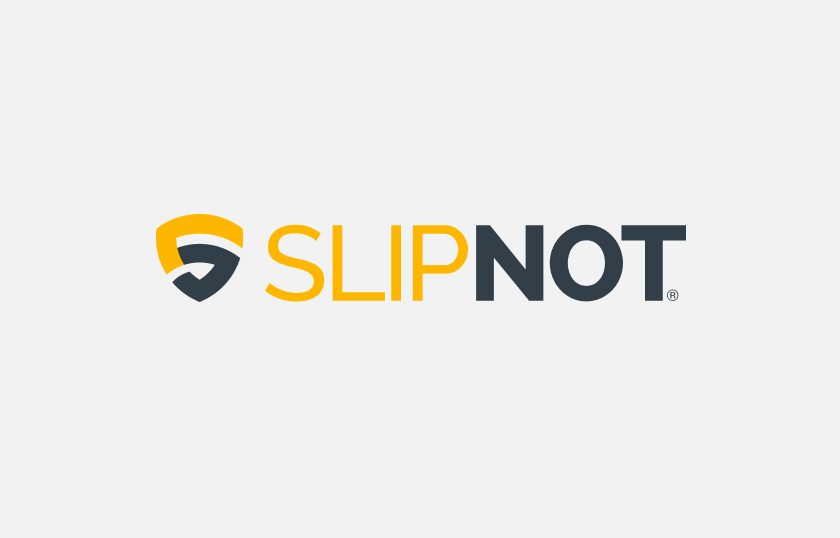Technical Information
Designed for applications where safety and efficiency are vital for industrial and commercial environments
3 Part Spec & CAD Details
SLIPNOT products can be easily incorporated into any project or specification. To assist architects and engineers in integrating SLIPNOT products into project details, the SLIPNOT CSI 3 part specification is provided based on The Construction Specifications Institute format. The SLIPNOT current specification is a brief description used for specifying the unique characteristics of the SLIPNOT material.
Current Specifications
CSI 3 Part Specifications
Why & How to Specify SLIPNOT
DWG Drawings
The CAD drawings below are examples of different types of material and fabrication that can be done. Custom drawings are available upon request; contact a representative for more information.
- 7-4GRATING.DWG
- 7-4GRATINGTREAD.DWG
- 11-4GRATING.DWG
- 11-4GRATINGTREAD.DWG
- 15-4GRATING.DWG
- 15-4GRATINGTREAD.DWG
- 15W4GRATING.DWG
- 15W4GRATINGTREAD.DWG
- 19-4GRATING.DWG
- 19-4GRATINGTREAD.DWG
- 19W4GRATING.DWG
- 19W4GRATINGTREAD.DWG
- CONVEYORPLATE.DWG
- CTREADANGLES.DWG
- CTREADHOLES.DWG
- CTREADNOHOLES.DWG
- EXPMTLTREAD.DWG
- LTREADANGLES.DWG
- LTREADHOLES.DWG
- LTREADNOHOLES.DWG
- NOSINGANGLE.DWG
- NOSINGHOLES.DWG
- NOSINGHOOKS.DWG
- PERFANGLE.DWG
- PERFL.DWG
- PERFPLATE.DWG
- PERFZ.DWG
- PLANKPUNCHED.DWG
- PLANKSMOOTH.DWG
- PLATE.DWG
- TRENCHPLATE.DWG
- ZTREADANGLE.DWG
- ZTREADHOLES.DWG
- ZTREADNOHOLES.DWG
PDF Drawings
To easily incorporate SLIPNOT into project details the PDF drawings are provided below as examples of fabrication that is available. Custom drawings are available upon request; please contact a representative for more information. Click to download:
- 7-4GRATING.PDF
- 7-4GRATINGTREAD.PDF
- 11-4GRATING.PDF
- 11-4GRATINGTREAD.PDF
- 15-4GRATING.PDF
- 15-4GRATINGTREAD.PDF
- 19-4GRATING.PDF
- 19-4GRATINGTREAD.PDF
- 19W4GRATING.PDF
- 19W4GRATINGTREAD.PDF
- CONVEYORPLATE.PDF
- CTREADANGLES.PDF
- EXPMTLTREAD.PDF
- LTREADANGLES.PDF
- LTREADHOLES.PDF
- LTREADNOHOLES.PDF
- NOSINGANGLE.PDF
- NOSINGHOLES.PDF
- NOSINGHOOKS.PDF
- PERFANGLE.PDF
- PERFL.PDF
- PERFPLATE.PDF
- PERFZ.PDF
- PLANKPUNCHED.PDF
- PLANKSMOOTH.PDF
- PLATE.PDF
- TRENCHPLATE.PDF
- ZTREADANGLE.PDF
- ZTREADHOLES.PDF
- ZTREADNOHOLES.PDF
Standards & Test Results
SLIPNOT products far exceed ALL standards and recommended guidelines for slip resistance. Certified independent laboratories have tested SLIPNOT products in accordance with various test methods. Please call 800-754-7668 or e-mail us at info@slipnot.com for hardcopy test results.
ASTM
ANSI A137.1
| SLIPNOT Dynamic Coefficient of Friction Test Results | ||||||||||||||
|---|---|---|---|---|---|---|---|---|---|---|---|---|---|---|
| Material | Dry | Wet | ||||||||||||
| ||||||||||||||
| ||||||||||||||
| ||||||||||||||
This test method measures dynamic coefficient of friction (DCOF) of common hard-surface indoor level floor materials. The BOT-3000E digital tribometer was utilized with a SBR rubber slider and 0.05% SLS water solution. Unless otherwise specified, tiles suitable for level interior spaces expected to be walked upon wet shall have a wet DCOF of 0.42 or greater.
Dry values are not applicable to this test.
ASTM C1028
| SLIPNOT Coefficient of Friction ASTM C1028 Methods | ||||||||
|---|---|---|---|---|---|---|---|---|
| Material | Dry | Wet | ||||||
| ||||||||
| ||||||||
| ||||||||
| ||||||||
This test method covers the measurement of static coefficient of friction of ceramic tile or other surfaces under both wet and dry conditions while utilizing neolite heel assemblies. This test method can be used in the laboratory or in the field. This test method uses a large 50 lb. drag-sled that is constructed in accordance with the procedure. The method also would be subject to adhesion problems on wet surfaces, but is approved for this use.
*Withdrawn in 2006
ASTM B101.3
| SLIPNOT Dynamic Coefficient of Friction Test Results | ||||||||
|---|---|---|---|---|---|---|---|---|
| Material | Dry | Wet | ||||||
| ||||||||
| ||||||||
| ||||||||
This test method measures dynamic coefficient of friction (DCOF) of common hard-surface floor materials. The BOT-3000E digital tribometer was utilized with a SBR rubber slider. The ANSI B101.3 standard recommends a minimum average DCOF of 0.43 for level floors and 0.46 for ramps.
Dry values are not applicable to this test.
ASTM D2047
| SLIPNOT Coefficient of Friction ASTM D2047 Methods | |||||||||||
|---|---|---|---|---|---|---|---|---|---|---|---|
| Material | Dry | Wet | |||||||||
| |||||||||||
| |||||||||||
| |||||||||||
This method is for the laboratory measurement of the static coefficient of friction of floor surfaces. The James Machine apparatus is not suitable for use on wet, rough, or corrugated surfaces. Because of the leather pad specification and problem with adhesion, this method should not be used for wet testing.
*Testing method (James Machine) no longer used
ASTM 1679
| SLIPNOT Coefficient of Friction ASTM F1679 Methods | |||||||||||
|---|---|---|---|---|---|---|---|---|---|---|---|
| Material | Dry | Wet | |||||||||
| |||||||||||
| |||||||||||
| |||||||||||
| |||||||||||
The premier testing method approved for both dry and wet testing. The testing method can be used on nearly all surfaces. This method avoids the problem of adhesion by applying the horizontal and vertical forces simultaneously. The English XL is the device used for this method. Operators should be certified to use the equipment.
*Withdrawn in 2006
ASTM 1677
| SLIPNOT Coefficient of Friction ASTM F1677 Methods | ||||||||
|---|---|---|---|---|---|---|---|---|
| Material | Dry | Wet | ||||||
| ||||||||
| ||||||||
| ||||||||
The premier testing method approved for both dry and wet testing. The testing method can be used on nearly all surfaces. This method avoids the problem of adhesion by applying the horizontal and vertical forces simultaneously. The English XL is the device used for this method. Operators should be certified to use the equipment.
ASTM 1678
This test method covers the operational procedures for using a portable articulated strut slip tester (PAST) to determine the slip resistance of footwear sole, heel, or related materials (test feet) against planar walkway surfaces or walkway surrogates (test surfaces) in either the laboratory or field under dry conditions.
ASTM F489
This covers laboratory measurement of the dry static coefficient of friction of shoe sole and heel materials on controlled walking surfaces and under controlled conditions. This method uses the stationary James Machine. This method is not used to test floor slip resistance.
ASTM D5859
This test method covers the measurement of the traction of footwear on painted walkway surfaces under both dry and wet conditions in the laboratory and the field. The method uses the English XL device. The method is out of date and will likely be withdrawn in the future in favor of ASTM 1679.
ASTM F462
This consumer safety specification covers the slip resistance of bathtubs and shower structures or combinations, used for bathing or showering. This consumer safety specification is intended to describe a means to reduce accidents to persons, especially children and the aged, resulting from the use of bathing facilities.
ASTM F1637
This practice covers design and construction guidelines and minimum maintenance criteria for new and existing buildings and structures. This practice is intended to provide reasonably safe walking surfaces for pedestrians wearing ordinary footwear. These guidelines may not be adequate for those with certain mobility impairments.
ASTM F802
This guide is intended to assist in the selection of walkway surfaces where the presence of foreign materials may produce the danger of a slip or a fall.
ANSI/NFPA
ANSI A1264.2
The A1264.2 sub-committee began writing a standard with the intent of reducing falls due to slippery conditions which in are some way preventable in the workplace. The three basic areas of the standard are:
- Provisions for reducing hazards
- Test equipment
- Slip resistance criteria
The first area constitutes the largest part of the standard and addresses: Footwear applications and considerations, Mats & Runners, Housekeeping, Warnings, Symbols, Controlled Access, Selection and/or treatment. The test equipment portion essentially refers to ASTM standards and test methods.
NFPA 1901
The National Fire Protection Association standard 1901 entitled Standard for Automotive Fire Apparatus has a specification in section 13-7.3 for slip resistance. It states that all external surfaces used for walking and standing shall have a slip resistance of at least 0.68 when wet as tested by the English XL VIT (per ASTM F1679 Standard Test Method for Using a Variable Incidence Tribometer), or at least 0.52 when wet as tested by the Brungraber Mark II PIAST (per ASTM F1677 Standard Test Method for Using a Portable Inclinable Articulated Strut Slip Test). Internal walking and standing surfaces must have a slip resistance of at least 0.58 per the English XL VIT or 0.47 per the Brungraber Mark II PIAST.
SLIPNOT exceeds the recommended coefficient of friction values set by the NFPA.
OSHA
OSHA requires the use of slip resistant surfaces in several locations in their standards.
29 CFR 1910.24(f)
“Stair treads.” All treads shall be reasonably slip-resistant and the nosings shall be of non-slip finish. Welded bar grating treads without nosings are acceptable providing the leading edge can be readily identified by personnel descending the stairway and provided the tread is serrated or is of definite non-slip design. Rise height and tread width shall be uniform throughout any flight of stairs including any foundation structure used as one or more treads of the stairs.
A proposed standard for Subpart D does make a reference to a 0.5 requirement for coefficient of friction. However, this standard was never promulgated as a final rule. Some product manufacturers point to this proposed standard as a rule to which employers must comply.
The most significant regulation affecting slip resistance can be found in the OSHA construction standards as they relate to steel erection.
1910.68 Subpart F – Powered Platforms, Manlifts, and Vehicle-Mounted Work Platforms
(c)(3)(v)
“Surfaces.” The upper or working surfaces of the step shall be of a material having inherent nonslip characteristics (coefficient of friction not less than 0.5) or shall be covered completely by a non-slip tread securely fastened to it.
1910 “Walking and Working Surfaces and Personal Protective Equipment; Notice of Proposed Rulemaking
This proposed rule issued by OSHA included a non-mandatory appendix specifying a minimum slip resistance of 0.5 as reasonable slip resistance performance. Although they are still on the books, none of the proposed revisions to subpart D has been promulgated at this time.
SLIPNOT products have a coefficient of friction that is greater than or equal to 0.85, exceeding all OSHA recommendations.
ADA
Americans with Disabilities Act (U.S. Department of Justice)
A4.5 Ground and Floor Surfaces.
A4.5.1 General. People who have difficulty walking or maintaining balance or who use crutches, canes, or walkers, and those with restricted gaits are particularly sensitive to slipping and tripping hazards. For such people, a stable and regular surface is necessary for safe walking, particularly on stairs. Wheelchairs can be propelled most easily on surfaces that are hard, stable, and regular. Soft loose surfaces such as shag carpet, loose sand or gravel, wet clay, and irregular surfaces such as cobblestones can significantly impede wheelchair movement.
Slip resistance is based on the frictional force necessary to keep a shoe heel or crutch tip from slipping on a walking surface under conditions likely to be found on the surface. While the dynamic coefficient of friction during walking varies in a complex and non-uniform way, the static coefficient of friction, which can be measured in several ways, provides a close approximation of the slip resistance of a surface. Contrary to popular belief, some slippage is necessary to walking, especially for persons with restricted gaits; a truly “non-slip” surface could not be negotiated.
The Occupational Safety and Health Administration recommends that walking surfaces have a static coefficient of friction of 0.5. A research project sponsored by the Architectural and Transportation Barriers Compliance Board (Access Board) conducted tests with persons with disabilities and concluded that a higher coefficient of friction was needed by such persons. A static coefficient of friction of 0.6 is recommended for accessible routes and 0.8 for ramps.
It is recognized that the coefficient of friction varies considerably due to the presence of contaminants, water, floor finishes, and other factors not under the control of the designer or builder and not subject to design and construction guidelines and that compliance would be difficult to measure on the building site. Nevertheless, many common building materials suitable for flooring are now labeled with information on the static coefficient of friction. While it may not be possible to compare one product directly with another, or to guarantee a constant measure, builders and designers are encouraged to specify materials with appropriate values. As more products include information on slip resistance, improved uniformity in measurement and specification is likely. The Access Board’s advisory guidelines on Slip Resistant Surfaces provides additional information on this subject.
SLIPNOT’s coefficient of friction (0.85 or greater) exceeds the recommendation of ADA (0.6 for flat surfaces and 0.8 for ramps).
Approvals & Certifications
SLIPNOT is an ISO 9001:2015 Registered Company, Registered by NSF International for use in the food processing industry and registered slip resistant with Underwriters Laboratories per the UL 410 and has been evaluated at almost double UL’s requirements for slip resistant materials.

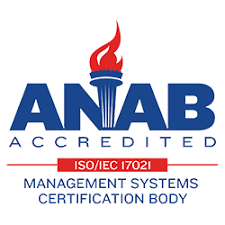
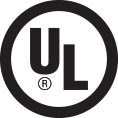

Download
Fabricating Instructions
Fabrication is best performed prior to SLIPNOT surface application. SLIPNOT does not recommend any fabrication of products after galvanizing. SLIPNOT products can however be treated similar to their smooth plate counterparts when fabricating. Material can generally be sheared, flame/torch cut, laser cut, water-jetted, plasma cut or welded, either directly or from the opposite side, without adversely effecting the SLIPNOT surface. The SLIPNOT surface bonds at over 4,000 psi and results in a hardened surface between 55 – 63 on the Rockwell “C” Scale.
The following is intended as a general informational guideline and may not account for all types of fabrication or installations. Please contact a SLIPNOT representative for additional information.
Drilling/Punching
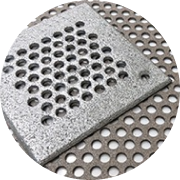
SLIPNOT material can be drilled and countersunk in most situations. Generally, due to the resulting surface hardness, pre-drilling material prior to the SLIPNOT application is recommended. Pre-drilled holes, countersinks, and counter bores are protected from the SLIPNOT process so screws/bolts will sit flush. Due to the surface hardness, if fabrication is done after SLIPNOT application, additional time and tooling costs should be figured into estimating and labor costs.
Shearing
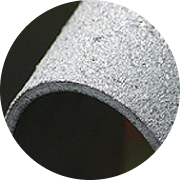
Due to the unique random stacked hatch matrix of the SLIPNOT surface, plates can usually be sheared. It is recommended that SLIPNOT material be flame, plasma, laser or water-jet cut to save wear and tear on tooling. Plates can also be sheared from the non-slip side to help minimize dulling of the shear blades, however, the roughened, hardened SLIPNOT surface can scratch shear tables.
Flame/Plasma
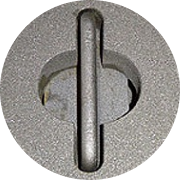
The unique SLIPNOT surface is bonded to substrates at over 4,000 psi and cutting with flame / plasma is no different than with smooth plates. This is the preferred method for fabricating SLIPNOT material with proper execution. The random matrix surface will not flake or delaminate along burn lines and will not be harmed by any standard burning operation.
Laser Cut
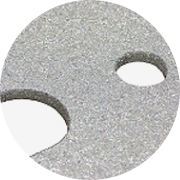
The random stacked hatch matrix surface of the SLIPNOT will add approximately 0.020” – 0.030” to any given substrate. These materials will not harm the optics of laser cutters so SLIPNOT materials can most often be treated exactly the same as non-SLIPNOT treated pieces. The laser will not harm the SLIPNOT surface in any way and the SLIPNOT surface will not damage any laser equipment.
Welding
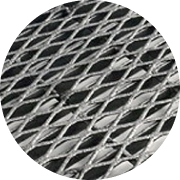
SLIPNOT is an all-metal, grit-free surface. Welding is generally performed exactly the same as required for the non-SLIPNOT treated counterparts. In most cases no special requirements are needed. Heat distortions and discolorations from any welding will be transmitted through the SLIPNOT surface and should be taken into account if aesthetics are critical to your project. Mounting angles or other such material can be pre-welded to materials and used as weld points during the installation process; minimizing the chances of surface blemishes. SLIPNOT does not recommend welding galvanized products.
Surface Masking/Detailing
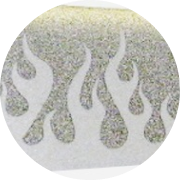
SLIPNOT is a molten metal plasma stream deposition and areas can be masked / protected from surface coating. In cases of stair treads, risers and nosings are masked and only the tread surface itself receives the SLIPNOT application. Logos, words, or patterns can also be created within the SLIPNOT surface application however, there can be additional costs associated with these procedures. For welded installations, small borders can be masked for easier metal working.
Galvanizing Guidelines
Care must be taken in the pickling portion of the hot dipped galvanizing process as the SLIPNOT surface may lift off if pickling times exceed recommendations. Care should also be taken when rack loading to allow for sufficient spacing between items so that the heat of the pickling process does not create “hot spots” within the pickling tanks and potentially damage the SLIPNOT surface. Listed below are suggestions and guidelines for galvanizing SLIPNOT steel products: SLIPNOT provides all galvanized steel products in accordance with ASTM A123.
Recommended
- Using ambient temperature hydrochloric acid
- Acid pickling times should not exceed ten (10) minutes for ambient temperature hydrochloric acid solutions
- Maintaining a constant temperature of 830° – 840° while in the galvanizing zinc bath
- Shot blast or sand blast any additional steel such as stringers, support angles, stiffeners, etc. prior to the galvanizing process along with being de-scaled and rust free
- Material should be kept inside and wrapped to prevent surface rust from forming
Not Recommended
- Do not leave material in acid pickling process for more than ten (10) minutes
- Do not use a heated sulfuric acid solution immersion for more than three (3) minutes
- Do not use an inconsistent temperature while in the galvanizing zinc bath
- Do not provide greasy, scaly, rusty material to the Galvanizer
- Do not allow exposure to the elements that can create surface rust
SLIPNOT strongly recommends that hot dipped galvanizing be provided by us or contracted directly with Voigt & Schweitzer Galvanizers LLC. For a local contact familiar with proper handling of SLIPNOT products in Redford, MI, see below:
Voigt & Schweitzer Galvanizers LLC
12600 Arnold Street | Redford, MI 48239
Jim Getz, Sales Director | Phone: (313) 535-2600 | Fax: (313) 535-0862
http://www.hotdipgalvanizing.com/
http://www.hotdipgalvanizing.com/locations/
If the SLIPNOT surface is galvanized by a 3rd party the above mentioned guidelines must be observed. Traction Technologies Holdings, LLC is not liable for damage to the SLIPNOT surface by 3rd parties. If galvanized incorrectly, the SLIPNOT surface can be compromised. If you have questions or require galvanized samples to test, please call (800) 754-7668 or (800) 754-7668.
SLIPNOT is not responsible for costs associated with replacement or repair of material fabricated, including but not limited to drilling or welding after galvanizing. Also, pieces damaged in material handling must be field repaired. Failure to adequately repair and protect compromised surfaces will result in pre-mature failure of the SLIPNOT and galvanized surfaces. SLIPNOT is not responsible for surface damage caused by either deliberate or incidental means.
Care & Cleaning
SLIPNOT products can be cleaned by most standard agents, please contact a sales representative for more information. Clean slip resistant products on a regular basis to prevent any build-up or residue that can cause the peaks and valleys to smooth over. Small debris can be dislodged easily with compressed air or a soft bristle brush. If the SLIPNOT material is subject to excessive greasy or oily environments, significant grime or sludge can fill in the valleys between the peaks of the SLIPNOT surface (in effect smoothing over the SLIPNOT), it requires cleaning with a stiff bristle brush or power washing to bring back the optimal surface texture.
Care for Steel Products

- Mill finish steel SLIPNOT products will rust if exposed to moisture or humidity.
- Material should be primed and painted or hot dipped galvanized to prevent corrosion.
- Hot dipped galvanizing is the ideal method for corrosion resistance.
- Use a power washer and stiff bristle brush to remove any debris lodged in peaks and valleys. Note: steel products should be protected due to corrosive nature.
- Organic based stains, such as grease or oil, can be removed with standard organic solvents. The most common is commercially available brake cleaner but any organic solvent will most likely work. Some scrubbing may be required to remove grease buildup.
- Detailed information available upon request.
Care for Stainless Steel Products
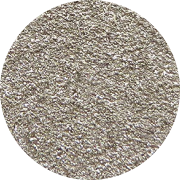
- Be aware that certain organic enzyme and alkaline based cleaning agents can blacken the stainless steel which will bleed through the SLIPNOT surface layer as well
- The stainless steel SLIPNOT is our most chemically resistant product and withstands nearly all other cleaning or environmental situations from alkaline to acidic. Also, the stainless steel products can be passivated to remove welding discolorations like stainless steel.
- Organic based stains, such as grease or oil, can be removed with standard organic solvents. The most common is commercially available brake cleaner but any organic solvent will most likely work. Some scrubbing may be required to remove grease buildup.
- Use a power washer and stiff bristle brush to remove any debris lodged in peaks and valleys.
- Should the stainless steel product be contaminated with surface rust, it is generally recommended that this be removed with diluted muriatic acid. Concentrations should not exceed 1 part acid to 1 part water.
Care for Aluminum Products
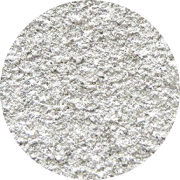
- Material should be handled with care.
- Aluminum is a soft alloy that can be damaged if not handled properly.
- Organic based stains, such as grease or oil, can be removed with standard organic solvents. The most common is commercially available brake cleaner but any organic solvent will most likely work. Some scrubbing may be required to remove grease buildup.
- SLIPNOT recommends that a stiffened bristle brush used in conjunction with a power washer – too much pressure can lead to degradation of the SLIPNOT surface.
- Standard Aluminum cleaning products such as Tri-Sodium Phosphate solutions work well.
Let's get started
The SLIPNOT team is efficient, expert and focused on providing you with the right safety solution. Please take a minute to complete this form to request a quote or sample. One of our safety professionals will be in touch to help guide you in making the right choice.

